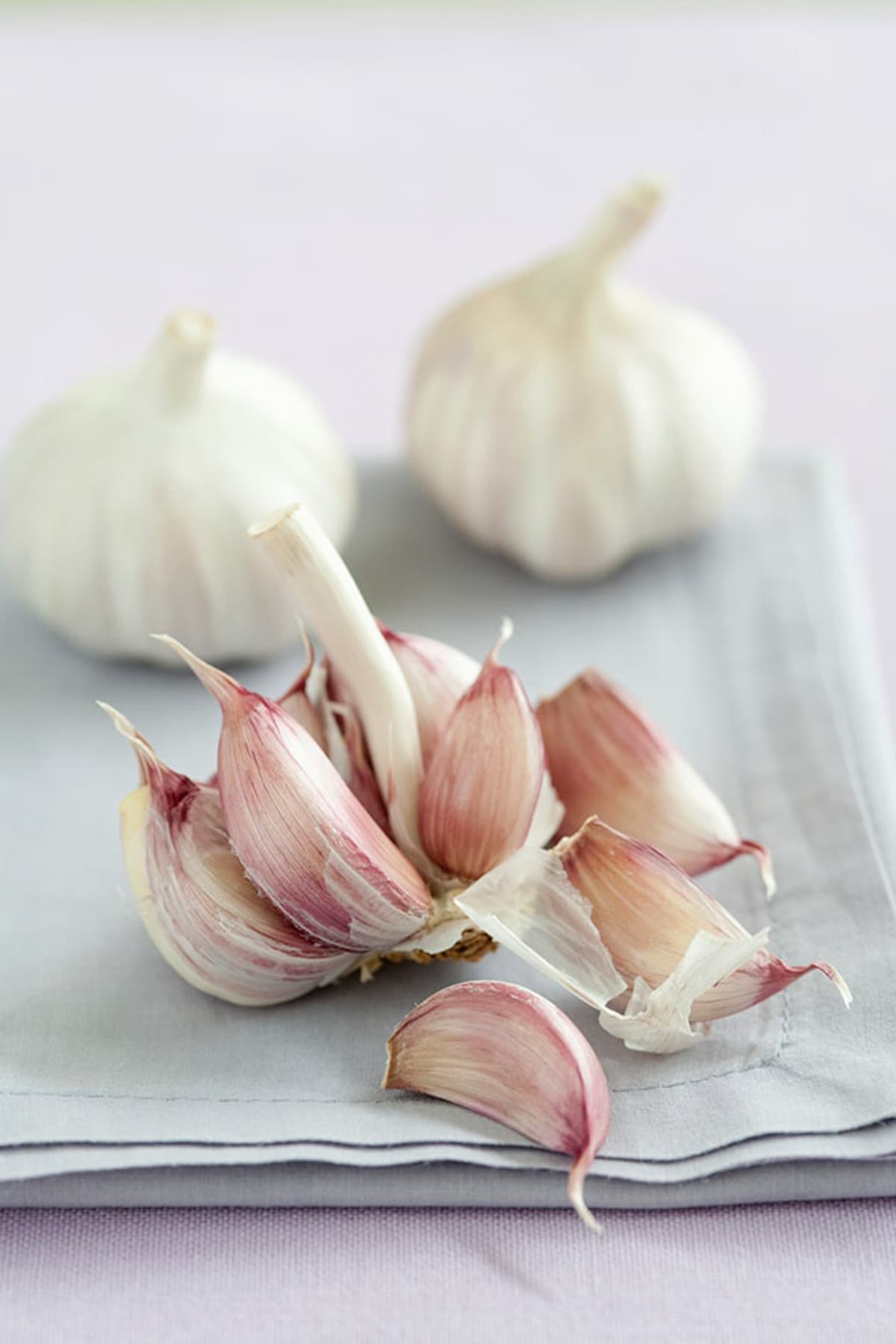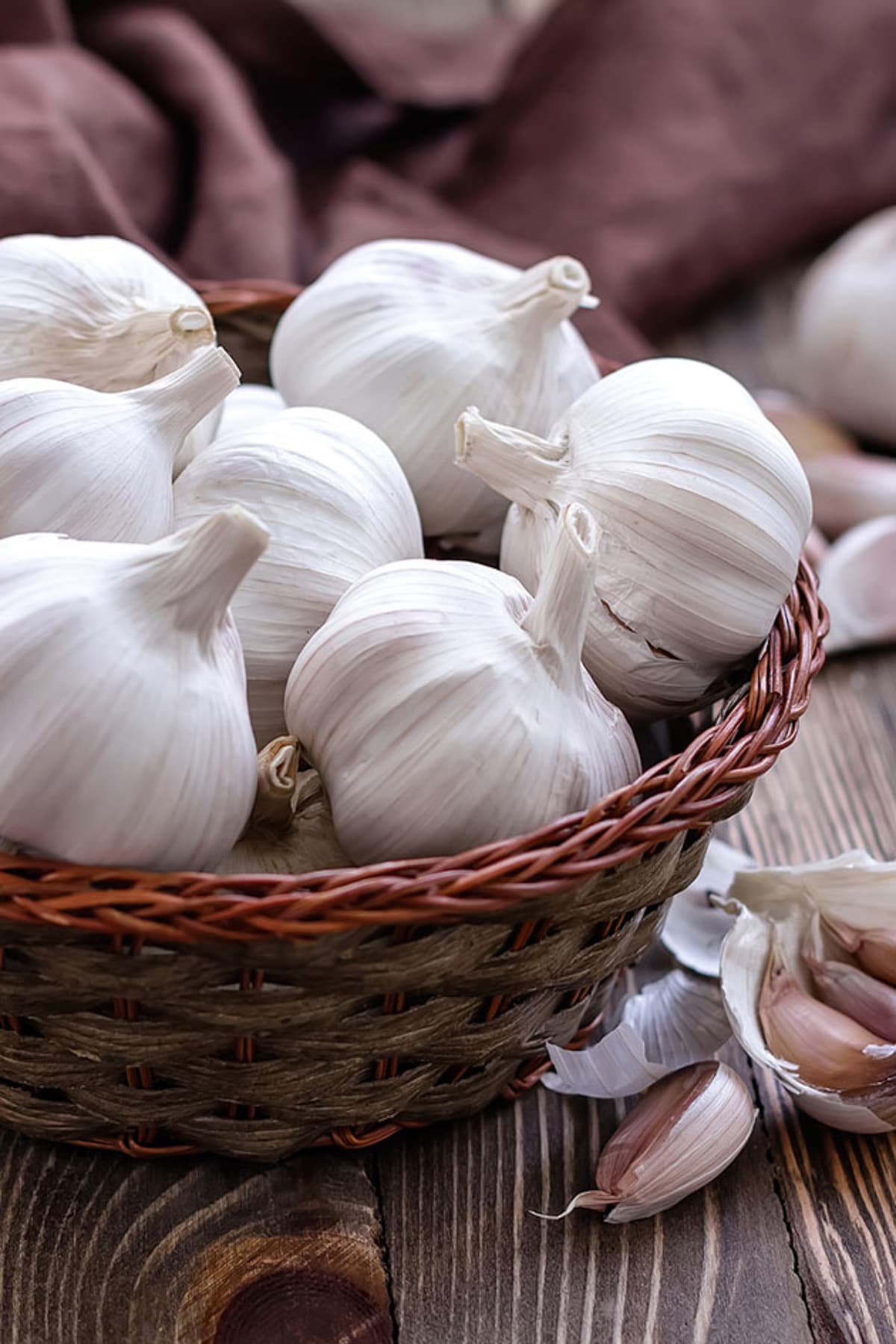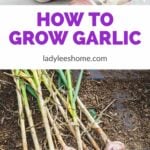Learn everything that you need to know about how to grow garlic. Growing garlic at home is not too hard and garlic can store for a long time. This is an amazing crop that should have space in everyone’s garden!
So many dishes start with garlic! It adds so much flavor to so many dishes. Not only that, but it also has so many health benefits. Aside from using it in the kitchen, you can also use it to keep your body strong and healthy.
The best thing for the gardener then, is that garlic is very easy to grow and store. It’s easy to plant since we plant cloves and they are big and easy to handle, pests don’t like garlic, it will grow in pretty much any kind of soil, we can plant it in the fall… The list goes on and on!
How to Grow Garlic at Home…

It’s also very easy to store garlic. All you’d need is a cool, dry place and your crop can last for a year or more at room temperature. And if that’s not enough, it’s really easy to become self-sufficient when it comes to garlic because you can plant some of the cloves you grew the previous year. Really, if you grow a garden, there is no reason why you won’t grow garlic! let’s go over all the details of how to grow garlic…
- Which Garlic Variety to Grow?
- Where to Get Garlic Seeds?
- When to Plant Garlic?
- How to Plant Garlic…
- A Few Other Ways to Grow Garlic…
- How to Care for Garlic Plants…
- When to Harvest Garlic…
- How to Harvest Garlic…
- How to Cure Garlic…
- How to Store Garlic After Curing…
- Frequently Asked Questions…
- More Gardening Tutorials…
Which Garlic Variety to Grow?
Let’s start by saying that you shouldn’t plant garlic that you got at the grocery store. First, you’ll see below that it might not be the right kind for your area, but even if it is, it might have been treated with chemicals to prevent it from sprouting. If you’re going to do the work of planting and caring for your garlic, you want to make sure that you’re going to get a nice harvest and a nice harvest starts with quality seed garlic.
Garlic is divided into two categories… Hard-neck garlic and soft-neck garlic…
- Hard Neck Garlic – is suitable for cold climates. Let’s say up to zone 7. This kind of garlic will give you a scape a few weeks before the bulb is ready for harvest. The scape is the flower stalk of the garlic.
If you choose a variety of hard-neck garlic you are really going to get two harvests; the scapes and the garlic bulbs. Learn how to harvest and how to use garlic scapes here. My favorite hard-neck garlic variety is Music. - Soft Neck Garlic – varieties in this category are suitable for warmer climates, let’s say zones 6 and up. Soft neck varieties won’t produce a scape but will most likely produce a larger bulb. My favorite soft-neck garlic variety is Transilvania.
So the first thing you need to know before you go and purchase your seed garlic is your growing zone. You can find it easily online by googling “(your town and state) growing zone”.
Where to Get Garlic Seeds?
Garlic seed is basically garlic cloves. When you get your garlic seed, you’re most likely going to get a bag of garlic bulbs (they usually go by weight) which you’re going to have to separate into individual cloves before planting your garlic.
You might be able to find seed garlic locally or you can order online. Pretty much every seed company has seed garlic. A great thing about ordering online is that you can usually place your order in the spring when you order other seeds and forget about it.
It will ship to you automatically in early fall so you can get ready for planting since planting garlic in the fall is the best way to go (more on that in a minute). Not all online companies do this. Make sure to check before you order. Some of my favorite online garlic seed suppliers are:
- Johnny’s Selected Seeds – always great seeds! This is where I buy most of my vegetable seeds so I’m sure the garlic is amazing too (I didn’t purchase garlic from Johnny’s in the past).
- Filaree Garlic Farm – one of the biggest “go-to” seed garlic companies around.

When to Plant Garlic?
The best time to plant garlic is in the fall, 4-6 weeks before your first frost. Our first frost here in zone 7b is around November 15th. This means that we want to plant garlic at the beginning or the middle of October.
Theoretically, you can plant garlic in the spring… But you won’t get beautiful, big bulbs like you would if you plant in the fall. Like all bulbs, garlic benefits from the cold temperatures of winter. When you plant it in the fall, it will germinate and grow a few inches, then it will hold. During the winter, the bulbs will work on developing a strong root system underground, then when the weather warms up a bit in the spring, the garlic shoots up and starts growing its green leaves and then its bulb.
Really, the main reason for planting garlic in the fall is the time winter allows it to develop a strong root system before the above-ground growth of spring and summer.
How to Plant Garlic…
Prepare your garden soil – choose a full-sun location, rich and loose soil, and most importantly a well-drained area. I am going to say this again… Garlic is not fussy about the amount of organic matter you have in the soil and you can always feed it during the growing season by fertilizing, however, it will suffer and will easily rot if the soil is too wet for long periods of time.
Prepare your garlic for planting – once your soil is ready and you are ready to plant you can go ahead and break the seed garlic heads into individual cloves. Make sure to be gentle so that you don’t damage the cloves. Also, do not peel them. Before planting, go over your cloves and choose the largest, healthiest cloves for planting. You can still plant small cloves, however, the largest cloves will produce the healthiest, largest garlic bulbs.
Plant your garlic – dig a trench or make individual holes about 2 inches deep (You can see in the video above that I used a butter knife to make individual holes for planting since we used a weed cover). Place your clove in the center of the trench or in the hole with its flat end down and its pointy end up. Then cover it with soil. Space your cloves 4-6 inches from each other in all directions.
Mulch… Or don’t – many places will tell you to mulch your garlic… But remember I said before that garlic doesn’t do well in soil that is always moist or wet? Well, this is what mulch does… It keeps the soil around the plant moist and it holds moisture.
You see… The hardest thing about growing garlic is the weeds. There are really not many, if any, pests to deal with. Even the chickens will stay away, but garlic leaves are thin and they don’t cover or shade the soil, so many weed seeds are exposed to the sun and germinate during the growing season.
So many gardeners will want to mulch garlic so they can control the weeds. I did this too a few years ago. I planted more than a thousand garlic cloves and mulched them heavily with straw (as I successfully do with many of my other vegetables) so I didn’t have to weed the massive bed.
Well, I didn’t do much weeding but I also didn’t do much harvesting. We have a lot of rain here in the spring and the straw mulch that I used kept the garlic bed too wet. Almost all of my cloves rotted away in that wet soil.
So here is my advice to you… Use a weed cover as you can see us do in the video above. It works great! If you choose to mulch, remove the mulch in the spring. If you want you can move it away completely but the most important part is that you move it away from the base of the plant. Leave some exposed soil around the base of the plant so the sun can dry the soil around the bulb, this way, it won’t rot.
Of course, you should consider your growing conditions. If you’re in the desert and can’t water much you might want to keep the mulch, but if you are in an area with wet springs and summers then I’d say move the mulch away from the plants.

A Few Other Ways to Grow Garlic…
- Grow garlic with a cover crop – an option to consider, to deal with weeds, is to grow cover crops between your garlic. I’ve never tried it but I can imagine garlic will grow great in rye grass for example. Learn more about the benefits of cover crops here.
- Grow garlic as a companion plant – don’t forget that garlic is a great companion to many plants. Pests don’t like garlic and it can actually help other plants that struggle in this department. Since it’s better to plant garlic in the fall, you’ll have to do a bit of planning. Plant it here and there, and in the spring/summer, add other plants around it. The garlic will help the other plants with the pests and the other plants will help shade the ground around the garlic and fight the weeds.
- Plant garlic in containers – ain’t nothing wrong with growing garlic in containers! It grows great and it doesn’t need a very deep container. 6 to 8 inches are enough.
How to Care for Garlic Plants…
- Weeding – make sure to keep your beds clean of weeds. Even if you chose to use a weed cover, it is still a good idea to weed around the base of the plants every couple of weeks.
- Watering – garlic does not need a lot of water. In fact, here, in central NC, most years we don’t water our garlic at all, the rain is enough. If you live in a very dry area with no rain, you’ll want to water your garlic. Like most garden vegetables, about an inch a week is sufficient.
- Fertilizing – garlic doesn’t need much and will grow in poor soil, however, you’d get a better crop if you feed it. You can amend the garlic bed with compost before planting. You can choose to add worm castings or slow-release organic fertilizer, or you can use fish emulsion.
- Harvesting garlic scapes – if you planted a hard-neck garlic variety, you’ll have to make sure to harvest the scapes. Learn everything that you need to know about harvesting garlic scapes here.
When to Harvest Garlic…
As the season progresses, you’ll notice that your garlic leaves are starting to dry. The two bottom leaves will dry completely and the rest will start to turn brown at their tips. You want to harvest your garlic when the plant still has about six green leaves. These leaves might be brown at their tips, however, the rest of them should still be green.
Make sure to harvest your garlic after a few dry days. We want the least moisture in the plant as possible. Ideally, harvest in the evening or on an overcast day so that as you pull the plants from the ground and lay them down, they don’t spend too much time in harsh, direct sun.
So, if at all possible, harvest after a dry week, in the evening hours, on an overcast day. That’s ideal, however, not always possible. But as close to those conditions as possible will be best for the crop.
How to Harvest Garlic…
Hold the plant at its neck and gently pull. If the soil is too hard, you can use a pitchfork or a garden fork (as you can see us do in the video above) to loosen the soil under the bulbs (be careful not to damage the bulbs!). I find that it’s usually easier for me to harvest soft-neck garlic than it is hard-neck garlic. Hard-neck garlic seems to have a deeper root system.
Do not peel the garlic or cut the roots or trim the leaves as you harvest your garlic. Also, do not leave your garlic laying on the ground for too long. Simply shake away some of the soil, bunch your garlic, and get it ready for curing.
How to Cure Garlic…
Curing garlic means hanging it to dry. You don’t have to cure garlic. If you only planted a few plants and you are going to use them right away, go ahead! Fresh garlic is so delicious and not as sharp as you might think it will be.
However, if you want to be able to keep your garlic for a few months at room temperature, you will have to cure your garlic. I usually make bunches of ten plants and tie them with twine. This seems to be not too many so there is good airflow between the bulbs.
You then want to hang your bunches in a dark, dry, cool area, with good airflow. We hang our garlic in the crawl space under the house. It’s almost like a basement. It’s dark and stays cool. We add a fan that is connected to one of those outlets that you can wirelessly control with your phone. We set it to turn on and off on a two-hour interval.
Remember that If you feel that there is too much moisture in the air you can always add a dehumidifier as well. Let your garlic hang for two weeks or so before taking it down and prepping it for storage.

How to Store Garlic After Curing…
Once your garlic is cured, take the bunches down and clean the plants. Trim the roots and cut the tops, leaving about an inch of the stem. Then peel one or two layers of paper or just brush the soil off the bulb. If you’re growing soft-neck garlic you can leave the stem and leaves and braid your garlic. It’s nice hanging it that way.
Store your garlic in mesh bags or in an open basket. Make sure that it is still away from direct sun (don’t put it on a windowsill), in a dry, well-ventilated area. Well-cured garlic can last up to a year in storage.
Frequently Asked Questions…
There isn’t much difference. Seed garlic will be stored by the grower in optimal conditions so it’s firm and healthy for planting time. Seed garlic is usually not sprayed and you can find better information about the variety and such. But garlic is garlic. We plant individual cloves to produce a bulb.
Yes! It’s easy to become self-sufficient when it comes to garlic. You can keep your best bulbs and plant them in the fall. When you clean your garlic, set aside the bulbs that seem to have the largest cloves in them. Make sure to store them well in a cool area so they stay firm until planting time.
I suggest you don’t. Sometimes they spray it with all kinda stuff to prevent it from sprouting while it’s in the store. Also, it might be very old and might not be the right variety to grow in your area even though it was sold in a local grocery store. Start with good seed garlic and from then on out, you can keep some of your own bulbs to plant the next time.
In all the years that I have grown garlic, I have not once had to deal with pests. Not even the bigger kind like deer or bunnies. I will suggest though, that you don’t keep planting garlic in the same exact spot year after year. Move it around in the garden so the soil can recover and benefit from other crops.
I hope that this guide on how to grow garlic was helpful! If you are new to growing garlic, I suggest that you choose one or two varieties that are right for your location and start there. You’ll figure out pretty quickly that garlic is probably the easiest crop in your garden!
More Gardening Tutorials…
- The Complete Guide to Growing Potatoes
- The Complete Guide to Growing Carrots
- How to Grow Beets
- Growing Matt’s Wild Cherry Tomatoes
- Growing Onions From Sets

Hi! I’m Lady Lee. I help homesteaders simplify their homesteading journey while still producing a ton of food! I am a single mother of four, I was born in Israel and raised in an agricultural commune called a Kibbutz. Now I homestead in central NC.



